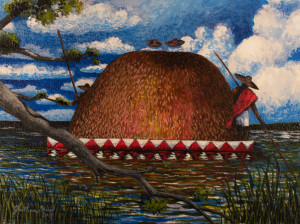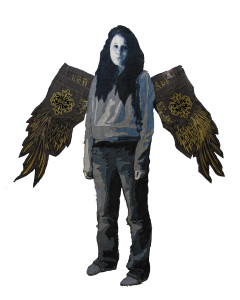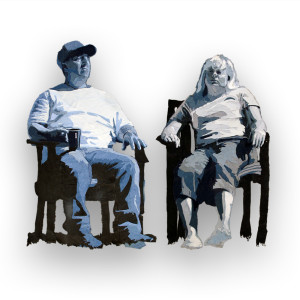At the time of the American Revolution, South Carolina was one of the richest of the original 13 colonies, thanks in large part to two lucrative agricultural products: rice, a highly valued food crop, and indigo, prized by Europeans as a dye for fabrics. Due to their seasonal nature, both crops could be grown using the same labor force – ultimately slave labor. Charleston, SC, became a major port city for both exporting and importing goods, including enslaved Africans.
Rice: Paintings by Jonathan Green and Indigo: Works in Denim by Jim Arendt, two coordinating exhibits coming to the Franklin G. Burroughs-Simeon B. Chapin Art Museum in Myrtle Beach in September, explore the effects of the culture of South Carolina laborers who worked these two crops – enslaved and free, colonial and modern-day – on contemporary perspectives and understandings of our State’s history. The exhibitions open Sept. 29, 2015 and run through Jan. 7, 2016.

On display will be 18 works from Green’s Rice series in addition to a variety of paintings inspired by the artist’s Gullah ancestry and culture as they relate to South Carolina rice cultivation, six in-depth descriptive text panels and a small collection of Lowcountry rice culture historical artifacts.
“Every time I approach the canvas to express my respect for my heritage and culture, I strive to capture the magnificent legacy my ancestors left my family and me despite their enslavement, oppression and horrific challenges they faced on a daily basis even after the Civil War and the Emancipation Proclamation,” says Green. “I marvel how under such conditions they were able to share such incredible love with one another, maintain a sense of community, create an atmosphere of belonging and instill in their children a sense of purpose and meaning in life.”
Representing the legacy of indigo are Works in Denim by Jim Arendt, Coastal Carolina University’s Rebecca Randall Bryan Gallery director and recipient of the 2013 ArtFields inaugural Grand Prize.
“Our region of South Carolina was shaped by the back-breaking work of African American slaves who produced the valuable blue dye of indigo, “says Arendt. “The work of these enslaved Africans is on display in the shape of our landscape. The blue dye of indigo, grown here in the heat of the summer sun and used to make the blue in jeans, is tinged with the bitterness of that work. I want people to think about our relationship with work and labor, so I use denim and the people I know to point at what work means, who does it and how it shapes their lives.”
His denim pieces are life-sized portrayals of close friends and family members – Arendt is careful not to call them portraits, as they are more likenesses of how he perceives their characters. Arendt grew up on a farm in Flint, MI, where he developed an appreciation for the manual labor contributed by his family members. To Arendt, their labor is representative of the hopes and dreams of their future, and it is his respect for such that drives his motivation to create. Moreover, his use of denim as a primary medium celebrates the tenacity and resilience of the rural people with whom Arendt grew up, as well as their values of thrift and “make-do.”
As well as art exhibitions for the public, these collections will form the basis for an educational outreach program designed to dovetail with the State’s school curriculum in South Carolina history, taught primarily in eighth grade. The Art Museum will be conducting tours of the exhibit for Horry and Georgetown County school groups, which will utilize the art experience to help enhance students’ understanding of the key role rice and indigo played in our state’s plantation economy.
Arendt will be on hand to provide a tour of the exhibition during a reception from5:30 to 7:30 p.m. Oct. 8. For those wishing a more hands-on experience, the artist will lead a workshop for all ages, from 2 to 4 p.m. Oct. 28, during which Museum guests will learn how to create works of art from their old denim jeans.
Also on display will be David Shriver Soliday: Remnants of the Rice Culture, an exhibition featuring aerial photography of old Lowcountry rice fields by David Shriver Soliday of Charleston, SC.
Gallery hours for the three exhibitions will be from 10 a.m. – 4 p.m. Tuesdaythrough Saturday, and 1 – 4 p.m. Sundays. The Art Museum is located at 3100 S. Ocean Boulevard in Myrtle Beach, across from Springmaid Pier. Admission is free, but donations are welcomed.



